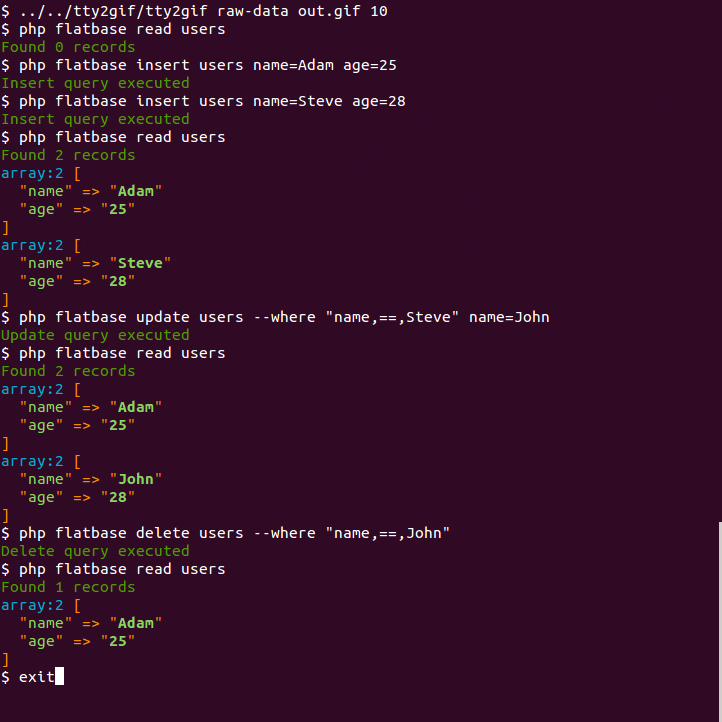Flatbase
Flatbase is a flat file database written in PHP which aims to be:, (*1)
- Lightweight
- Very easy to install, with minimal/no configuration
- Simple intuitive API
- Suitable for small data sets, low-load applications, and testing/prototyping
Example Usage
<?php
$storage = new Flatbase\Storage\Filesystem('/path/to/storage/dir');
$flatbase = new Flatbase\Flatbase($storage);
$flatbase->insert()->in('users')
->set(['name' => 'Adam', 'height' => "6'4"])
->execute();
$flatbase->read()->in('users')
->where('name', '=', 'Adam')
->first();
// (array) ['name' => 'Adam', 'height' => "6'4"]
Installation
composer require flatbase/flatbase
Usage
Reading
Fetch all the records from a collection:, (*2)
$flatbase->read()->in('users')->get(); // Flatbase\Collection
Reading only data matching a certain criteria:, (*3)
$flatbase->read()->in('users')->where('id', '==', '5')->get();
We support all the comparison operators you'd expect:, (*4)
You can chain as many where() conditions as you like:, (*5)
$flatbase->read()
->in('users')
->where('age', '<', 40)
->where('age', '>', 20)
->where('country', '==', 'UK')
->get();
Limit the returned records:, (*6)
$flatbase->read()->in('users')->limit(10)->get(); // Get the first 10 records
$flatbase->read()->in('users')->skip(5)->limit(10)->get(); // Skip the first 5, then return the next 10
$flatbase->read()->in('users')->first(); // Get the first record
Sort the records:, (*7)
$flatbase->read()->in('users')->sort('age')->get(); // Sort by age in ascending order
$flatbase->read()->in('users')->sortDesc('age')->get(); // Sort by age in descending order
Just get a count of records:, (*8)
$flatbase->read()->in('users')->count();
Deleting
Delete all records in a collection:, (*9)
$flatbase->delete()->in('users')->execute();
Or just some records:, (*10)
$flatbase->delete()->in('users')->where('id', '==', 5)->execute();
Inserting
$flatbase->insert()->in('users')->set([
'name' => 'Adam',
'country' => 'UK',
'language' => 'English'
])->execute();
Updating
Update all records in a collection:, (*11)
$flatbase->update()->in('users')->set(['country' => 'IE',])->execute();
Or just some records:, (*12)
$flatbase->update()
->in('users')
->set(['country' => 'IE',])
->where('name', '==', 'Adam')
->execute();
SQL Cheat Sheet
| SQL Statement |
Flatbase Query |
SELECT * FROM posts |
$flatbase->read()->in('posts')->get(); |
SELECT * FROM posts LIMIT 0,1 |
$flatbase->read()->in('posts')->first(); |
SELECT * FROM posts WHERE id = 5 |
$flatbase->read()->in('posts')->where('id', '==', 5)->get(); |
SELECT * FROM posts WHERE views > 500 |
$flatbase->read()->in('posts')->where('views', '>', 500)->get(); |
SELECT * FROM posts WHERE views > 50 AND id = 5 |
$flatbase->read()->in('posts')->where('views', '>', 50)->where('id', '==', '5')->get(); |
UPDATE posts SET title = 'Foo' WHERE content = 'bar' |
$flatbase->update()->in('posts')->set(['title' => 'var'])->where('content', '==', 'bar')->execute(); |
DELETE FROM posts WHERE id = 2 |
$flatbase->delete()->in('posts')->where('id', '==', 2)->execute(); |
INSERT INTO posts SET title='Foo', content='Bar' |
$flatbase->insert()->in('posts')->set(['title' => 'Foo', 'content' => 'Bar')->execute(); |
Command Line Interface
Flatbase includes a command line interface flatbase for quick manipulation of data outside of your application., (*13)
php vendor/bin/flatbase read users
Installation
To use the CLI, you must define the path to your storage directory. This can either be done with a flatbase.json file in the directory you call flatbase from (usually your application root):, (*14)
{
"path": "some/path/to/storage"
}
Alternatively, simply include the --path option when issuing commands. Eg:, (*15)
php vendor/bin/flatbase read users --path="some/path/to/storage"
Demo
 , (*16)
, (*16)
Usage
# Get all records
php flatbase read users
# Get the first record in a collection
php flatbase read users --first
# Count the records in a collection
php flatbase read users --count
# Get users matching some where clauses
php flatbase read users --where "name,==,Adam" --where "age,<,30"
# Update some record(s)
php flatbase update users --where "age,<,18" --where "age,>,12" ageGroup=teenager
# Insert a new record
php flatbase insert users name=Adam age=25 country=UK
# Delete some record(s)
php flatbase delete users --where "name,==,Adam"
For more info on the CLI, use one of the help commands, (*17)
php flatbase help
php flatbase read --help
php flatbase update --help
php flatbase insert --help
php flatbase delete --help
Why use a flat file database?
What are some of the advantages of a flat file database?, (*18)
It's really easy to get started
Just add flatbase/flatbase to your composer.json and you're rolling. No need for any other services running., (*19)
It's schema-less
You don't have to worry about defining a schema, writing migration scripts, or any of that other boring stuff. Just instantiate Flatbase and start giving it data. This is particularly useful when developing/prototyping new features., (*20)
Store plain old PHP objects
Data is stored in a native PHP serialized array using PHPSerializer. This means that you can store plain old PHP objects straight to the database:, (*21)
$flatbase->insert()->in('users')->set([
'id' => 1,
'name' => 'Adam',
'added' => new DateTime()
])->execute();
$record = $flatbase->read()->in('users')->where('id', '==', 1)->first();
var_dump($record['added']); // DateTime
It also means that you can, at any point, easily unserialize() your data without having to go through Flatbase if you wish., (*22)
Note: Although serializing is possible, be careful when using this in production. Remember that if you serialize an object, and then, later on, delete or move the class it was an instance of, you won't be able to un-serialize it. Storing scalar data is always a safer alternative., (*23)
It isn't actually that slow
Ok, that's a bit of a baiting title. Some operations are remarkably quick considering this is a flat file database. On a mediocre Ubuntu desktop development environment, it can process around 50,000 "inserts" in 1 second. No, that is still nowhere near a database like MySQL or Mongo, but it's a hell of a lot more than most people need., (*24)
Reading data out is certainly a lot slower, and although there are lots of places we can optimise, ultimately you'd need to accept this is never going to be a high-performance solution for persistence., (*25)
Author
Adam Nicholson - adamnicholson10@gmail.com, (*26)
Contributing
Contributions are welcome, and they can be made via GitHub issues or pull requests., (*27)
License
Flatbase is licensed under the MIT License - see the LICENSE.txt file for details, (*28)
 Wallogit.com
Wallogit.com
 , (*16)
, (*16)